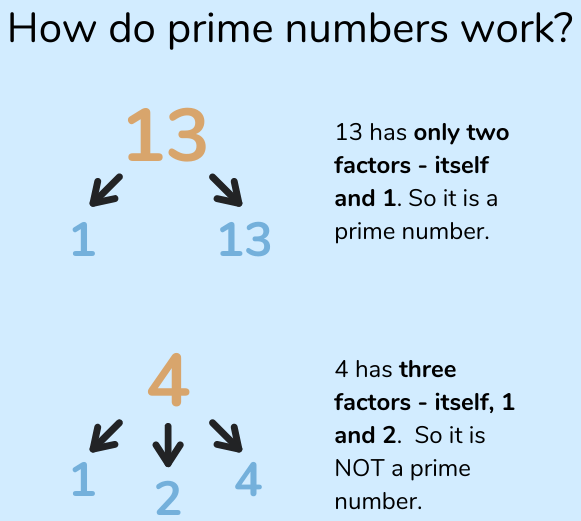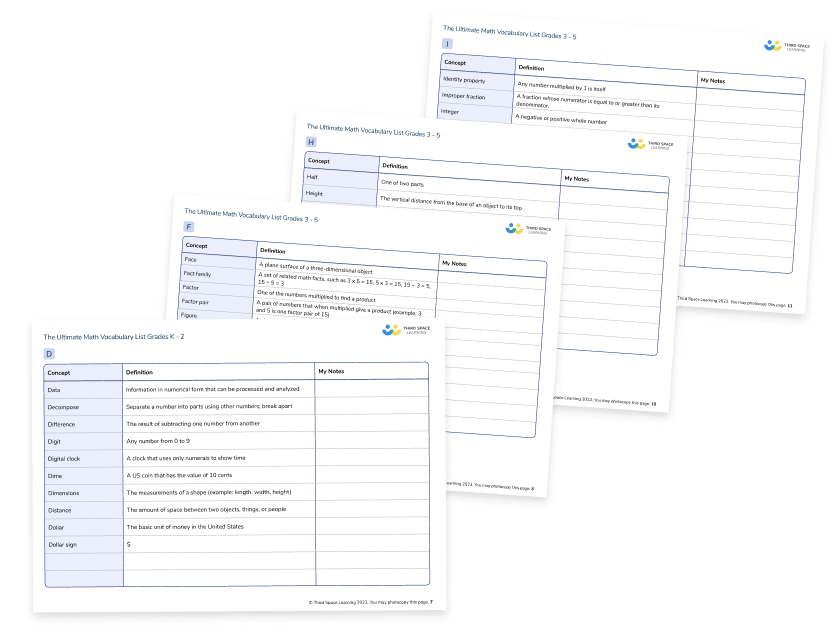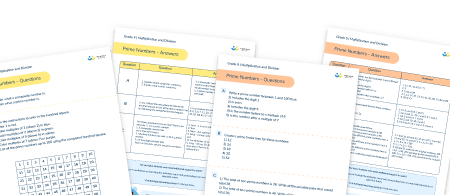What Is A Prime Number? Explained For Teachers
A prime number is a number that can only be divided by itself and 1 without remainders. Here, we explain exactly what this means, give you a list of the prime numbers children need to know at elementary and middle school, and provide you with some practice prime number questions and examples.
What is a prime number?
A prime number is a whole number greater than 1 with only two factors – itself and 1.
A prime number cannot be divided by any other positive integers without leaving a remainder, decimal, or fraction.
An example of a prime number is 13. Its only divisors are 1 and 13. Dividing a prime number by another natural number results in numbers leftover. For example, 13 ÷ 6 = 2 remainder 1.
15 is not an example of a prime number because it can be divided by 5 and 3 as well as by itself and 1.
15 is an example of a composite number because it has more than two factors.
Prime numbers are often seen as “building blocks” by mathematicians in number theory. The fundamental theorem of arithmetic states that a composite number can be expressed as the product of prime numbers.
See also: Divisibility Rules
Working With Prime Numbers
Explore students' understanding of prime numbers with these worksheets which focus on the multiplication and division of prime numbers. Questions are designed by math experts to encourage students to explore and explain their understanding.
Download Free Now!Prime number examples
How to work out if a given number is a prime number or a composite number, based on the properties of prime numbers.

What are the prime numbers?
- There are 8 prime numbers under 20: 2, 3, 5, 7, 11, 13, 17 and 19.
- The first 10 prime numbers are 2, 3, 5, 7, 11, 13, 17, 19, 23, 29.
- There are 25 prime numbers between 1 and 100.
- Prime numbers include large numbers and can continue well past 100.
- For example, 21,577 is a prime number.
List of prime numbers to 100
2, 3, 5, 7, 11, 13, 17, 19, 23, 29, 31, 37, 41, 43, 47, 53, 59, 61, 67, 71, 73, 79, 83, 89, 97
Notice that this list of prime numbers contains only odd numbers, with the exception of number 2.

Meet Skye, the voice-based AI tutor making math success possible for every student.
Built by teachers and math experts, Skye uses the same pedagogy, curriculum and lesson structure as our traditional tutoring.
But, with more flexibility and a low cost, schools can scale online math tutoring to support every student who needs it.
Find out moreSmallest prime number
2 is the smallest prime number. It is also the only even prime number – all other even numbers can at least be divided by themselves, 1, and 2, meaning they will have at least 3 factors.
Largest prime number
Greek mathematician Euclid (one of the most famous mathematicians of the classical era), recorded a proof that there is no largest prime number among the set of primes. However, many scientists and mathematicians are still searching to find it as part of the Great Internet Mersenne Prime Search.
The largest known prime number (as of November 2020) is 282,589,933 − 1, a number that has 24,862,048 digits when written in base 10. Before then, the largest known prime number was 277,232,917 − 1, having 23,249,425 digits.
By the time you read this, it might be even larger, but you can follow its progress on Wikipedia.
Common FAQs about prime numbers
A prime number is a number that can only be divided by itself and 1 without remainders.
The prime numbers from 1 to 100 are: 2, 3, 5, 7, 11, 13, 17, 19, 23, 29, 31, 37, 41, 43, 47, 53, 59, 61, 67, 71, 73, 79, 83, 89, 97.
1 is not a prime number because it has only one factor, namely 1. Prime numbers need to have exactly two factors.
2 is a prime number because its only factors are 1 and itself.
51 is not a prime number because it has 3 and 17 as divisors, as well as itself and 1. In other words, 51 has four factors.
Working With Prime Numbers
Explore students' understanding of prime numbers with these worksheets which focus on the multiplication and division of prime numbers. Questions are designed by math experts to encourage students to explore and explain their understanding.
Download Free Now!How are prime numbers used in the real world?
One of the most important uses for prime numbers is in cyber security – making information shared over the internet safer.
In order to encrypt (make secure) things like credit card details, medical records, and even some messaging services like WhatsApp, software engineers create algorithms using prime numbers.
By multiplying two very large prime numbers together (some companies use prime numbers that are hundreds of digits long!), we create an even larger number whose original factors (the two very large prime numbers) are only known to us. We then use this even larger number to encrypt our information.
If anyone else wants to discover what information we are sending, they have to find out what our original factors were. With prime numbers as long as the ones we have used, it could take them years or even decades of constant trial and error before they find even one. This kind of public-key cryptography ensures our information is kept safe.
Wondering how to explain other key math vocabulary to your children? Check out our Primary Maths Dictionary, or try these primary math terms:
- What Is A Cube Number: Explained For Primary Parents and Kids
- What Is The Lowest Common Multiple: Explained For Primary Parents And Kids
- What Is The Highest Common Factor: Explained For Primary Parents And Kids
Prime number questions
1) A square number and a prime number have a total of 22. What are the two numbers?
A: 9 and 13
2) Emma thinks of two prime numbers. She adds the two numbers together. Her answer is 36. Write all the possible pairs of prime numbers Emma could be thinking of.
A: 3 and 33; 5 and 31; 7 and 29; 13 and 23; 17 and 19
3) Circle the two prime numbers – 29, 59, 39, 69, 29
A: 29 and 59
4) Write the three prime numbers which multiply to make 231.
A: 3 x 7 x 11
CHALLENGE QUESTION: Chen chooses a prime number. He multiplies it by 10 and then rounds it to the nearest hundred. His answer is 400. Write all the possible prime numbers Chen could have chosen.
A: 37, 41 or 43.
Prime number worksheets
Prime number videos
Do you have students who need extra support in math?
Skye—our AI math tutor built by experienced teachers—provides students with personalized one-on-one, spoken instruction that helps them master concepts, close skill gaps, and gain confidence.
Since 2013, we’ve delivered over 2 million hours of math lessons to more than 170,000 students, guiding them toward higher math achievement.
Discover how our AI math tutoring can boost student success, or see how our math programs can support your school’s goals:
– 3rd grade tutoring
– 4th grade tutoring
– 5th grade tutoring
– 6th grade tutoring
– 7th grade tutoring
– 8th grade tutoring
The content in this article was originally written by primary school teacher Sophie Bartlett and has since been revised and adapted for US schools by elementary math teacher Katie Keeton.







